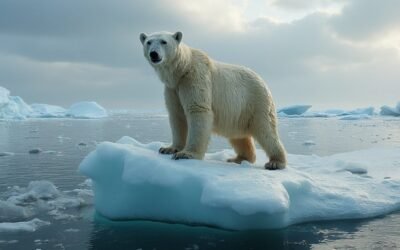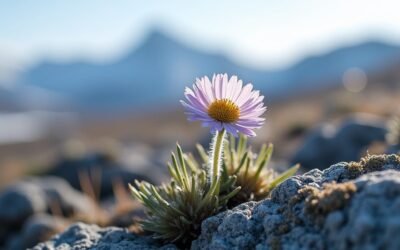Harp seals begin their migration from late March to early April, traveling from breeding areas to feeding territories in the Arctic and North Atlantic Oceans. This journey spans over 3,100 miles, optimizing their access to seasonal sea ice and abundant food sources. The timing of their migration is essential for enhancing reproductive success and pup survival, as it aligns with critical periods for mother-pup bonding and feeding. Understanding these seasonal behaviors is vital for developing effective conservation strategies that support their populations. Explore more about the factors influencing their migration and conservation efforts that aid their journey.
Main Points
- Harp seal migration starts in late March or early April.
- Migration aligns with the availability of sea ice and food sources.
- Routes can cover over 3,100 miles roundtrip from breeding to feeding grounds.
- Migration spans from April to July, adapting to environmental conditions.
- Migration timing enhances survival and reproductive success.
Migration Patterns
During the spring months, harp seals start extensive migrations from their breeding grounds to feeding territories in the Arctic and North Atlantic Oceans. This migration typically commences in late March and early April, marking the best season for these marine mammals to begin their journey. The routes they undertake can span over 3,100 miles roundtrip, highlighting their remarkable endurance and navigational capabilities.
Harp seals' migration patterns are intricately influenced by the availability of sea ice and food sources. The presence of sea ice is essential as it provides a stable platform for rest and protection from predators. Additionally, the distribution and abundance of food sources, such as fish and crustaceans, in the Arctic and North Atlantic Oceans play a significant role in directing their movement. As they leave their breeding grounds, harp seals navigate towards areas rich in these essential resources to sustain their energy needs.
The timing of this migration is crucial, aligning with the seasonal availability of sea ice and food sources. By migrating during the best season, harp seals maximize their chances of survival and reproductive success, ensuring that they reach their feeding grounds in the finest possible condition.
Breeding Season
The breeding season for harp seals typically occurs in late February to March, aligning with the arrival of pups in regions such as the Greenland Sea. This period is essential for guaranteeing the survival and growth of the newborn pups. During the breeding season, harp seals undertake a migration to specific areas where conditions are ideal for pupping and nursing.
Mother-pup bonding is a crucial aspect of this season. The synchronization of pupping activities allows for coordinated care and increases the chances of pup survival. Here are four key elements of the breeding season:
- Migration: Harp seals travel to specific regions like the Greenland Sea to give birth.
- Mother-pup bonding: This bonding period is vital for the development and eventual independence of the pups.
- Nursing: Female harp seals nurse their pups with nutrient-rich milk, which is indispensable for their rapid growth.
- Survival and growth: The conditions during the breeding season are optimized to enhance the survival rate and growth of the young seals.
The synchronization of these activities guarantees that the harp seal population can thrive, with each generation successfully reaching maturity. Therefore, the breeding season is a cornerstone of harp seal life cycles, facilitating the continuation of the species.
Feeding Habits
Harp seals display diverse feeding habits, consuming a wide range of fish and invertebrates that vary seasonally and geographically. As opportunistic feeders, they adjust their diet based on the availability of prey in different feeding locations. During the nursing period, harp seal pups rely on high-fat and high-protein milk, which is essential for their rapid growth.
The feeding behavior of harp seals is marked by intense feeding periods, particularly in the late summer and autumn. This intense feeding is crucial for building the energy reserves needed for the harsh winter months and subsequent migrations. The availability of pack ice plays a significant role in influencing their feeding habits, as it impacts the accessibility and distribution of prey. Consequently, diet variations are observed along different migration routes, with harp seals consuming various fish species depending on their location.
As they migrate, harp seals encounter diverse ecosystems, leading to shifts in their primary food sources. For example, in some regions, they may mainly feed on capelin and herring, while in others, their diet may include more invertebrates such as crustaceans. These adaptations underscore the flexibility and resilience of harp seals in maneuvering their dynamic marine environment.
Seasonal Behavior
Migrating in the spring and summer months, harp seals traverse vast distances to reach their nutrient-rich feeding grounds in the Arctic and North Atlantic Oceans. This migration, typically spanning from April to July, is an important journey that covers over 3,100 miles roundtrip. The seasonal behavior of harp seals is influenced by several key factors that determine the success of their migration.
Key elements influencing harp seal migration include:
- Sea Ice: The presence of sea ice is essential as it provides resting platforms during their extensive travels.
- Ocean Currents: These currents facilitate the movement of harp seals, aiding their navigation towards feeding grounds.
- Prey Abundance: The availability of prey, such as fish and crustaceans, in the Arctic and North Atlantic Oceans is a primary driver of their migratory patterns.
- Population Dynamics: Understanding the migration patterns helps in monitoring the population dynamics of harp seals, ensuring effective conservation strategies.
Harp seals' migration is a crucial aspect of their survival, directly linked to the ecological conditions of their habitat. By comprehending their seasonal behavior, scientists and conservationists can better monitor and protect these marine mammals, adjusting efforts to preserve their populations amidst changing environmental conditions.
Conservation Efforts
Effective conservation efforts are pivotal in safeguarding the breeding and feeding habitats essential for the successful migration of harp seals. These efforts focus on monitoring migration routes to understand population dynamics and identify potential threats. Collaborative initiatives address challenges like climate change, habitat degradation, and human impacts on harp seal migration.
Implementing marine protected areas along migration routes is a key strategy. These areas safeguard critical habitats for harp seals and other marine species. Sustainable fishing practices are equally important, as they reduce human disturbances and help maintain the natural migration patterns of harp seals.
The following table provides an overview of key aspects related to harp seal conservation efforts:
| Aspect | Details |
|---|---|
| Conservation Efforts | Protect breeding and feeding habitats |
| Migration Routes | Monitoring routes to understand population dynamics |
| Collaborative Initiatives | Address climate change, habitat degradation, and human impacts |
| Marine Protected Areas | Safeguard critical habitats along migration routes |
| Sustainable Fishing | Reduce human disturbances and support natural patterns |
What Is the Best Season to View Harp Seal Migration Based on Their Patterns?
The best season to view harp seal migration is during late winter and early spring when they gather to give birth on ice floes. These months offer the most opportunities to witness their journey up close. For more insight into timing and locations, follow useful harp seals migration tips.
When Is the Best Season to Witness Harp Seal Migration?
The best time to witness harp seal migration is typically during the late winter months, from February to March. During these harp seal migration seasons, the seals travel to the ice-covered waters around Canada’s Gulf of St. Lawrence and Newfoundland, where they give birth and find refuge on the floating ice.
Conclusion
Understanding the best season for harp seal migration involves examining their migration patterns, breeding season, feeding habits, and seasonal behavior. Conservation efforts are essential in protecting these marine mammals as they navigate their migratory routes. The integration of these aspects reveals that the late winter to early spring period is crucial for harp seal migration, aligning with their breeding season and the availability of food resources, thereby ensuring their survival and reproductive success.


